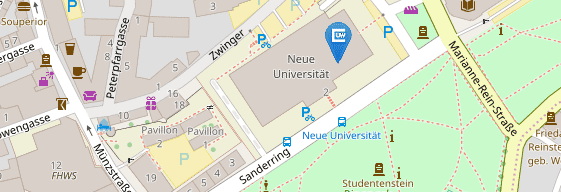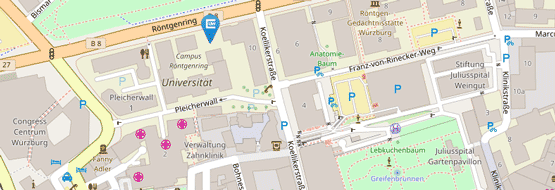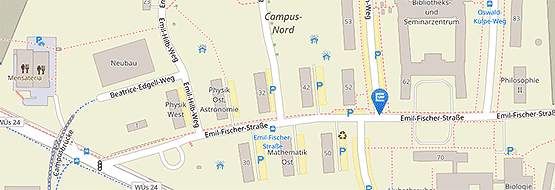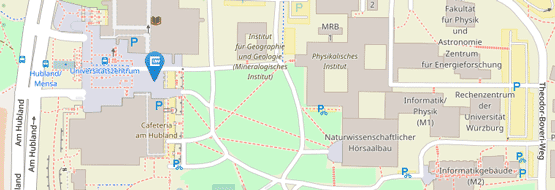Quality management tools
The quality management tools listed here are implemented in all faculties and are fixed components of either the annual monitoring of the degree programmes or the 8-year cycle. In addition, most faculties also maintain individual formats such as closed meetings, fireside chats and discussions with students, which promote regular dialogue about quality in teaching and studies and result in rapidly implemented measures for further development. This commitment should be expressly recognised at this point.
Surveys in the area of studying and teaching are a classic instrument for obtaining an opinion of the student body or teaching staff on certain topics or questions. In addition to course evaluation, surveys are tools to systematically generate information to optimise studies and teaching.
You can find out more about the surveys, the evaluation regulations and the software used under Survey system.
| Objective | The university management - represented by the Vice President responsible for studies and teaching and/or quality management - and the respective management of a faculty or central institution related to studies and teaching take time once a year for a joint review of the situation in studies and teaching at a faculty. The focus is on the respective experiences, concerns and developments of a faculty and its degree programmes or a central institution. Strategic concerns of the university management are also discussed in the meetings. |
| Frequency | Annually in the winter semester. |
| Topics | The starting point for the annual talks for the faculties are the current teaching reports. The starting point for annual talks with central institutions are selected key questions. |
| Organisation | The meetings are part of the university-wide QM system and a qualitative component of the annual monitoring. Central QM organises the meetings (scheduling, taking minutes, following up on agreements) together with the Vice-President responsible for teaching and learning and/or quality management. |
| Follow-up | A record of the results ofthe meeting is drawn up promptly with the key agreements and contents of the meeting and agreed with both parties. The results of the annual meetings and their implementation are taken up again in the following year's teaching report and by the central institutions in the next annual meeting. The agreements with the university management are reported on in an appropriate manner in the faculty councils or within the central institutions as part of the respective communication structures. Overarching, relevant findings that are the responsibility of the university management are transferred into measures at the annual quality conference, if necessary, and recorded in the annual quality report of the university management. |
| Downloadprocedure description annual review |
To close the quality cycle in studies and teaching at university level, a meeting is held once a year under the chairmanship of the Vice President for Studies and Teaching with the Deans of Studies and the Quality Officers with the participation of the student advisory board of the Centre for Academic Education and Teaching (ZBL) and the QM team of Department A.3 as a quality conference.
| Objectives |
|
| Procedure description | Step 1: Preparation In preparation for the quality conference, Unit A.3 drafts the quality report and agrees it with the Vice President for Studies and Teaching and the Presidential Commission for Quality in Studies and Teaching (PfQ). Step 2: Quality conference The deans of studies, the faculty quality officers and the members of the ZBL student advisory board are invited to the quality conference. One week before the meeting, they are provided with the draft quality report and any supplementary documents. Step 3: Follow-up The results of the quality conference are recorded in the minutes by Unit A.3. Relevant results of the quality conference are included in the quality report. Step 4: Decision of the university management The completed draft of the quality report is submitted by Unit A.3 to a meeting of the university management for a resolution. Step 5: Publication The quality report is published internally on the University's website following the decision by the University Executive Board. Step 6: Follow-up Unit A.3 is responsible for initiating the measures agreed. Their results are presented at the following quality conference and recorded in the quality report. |
| Download procedure description quality conference |
| Objectives | Every degree programme undergoes the subject audit procedure once within an eight-year cycle. At the centre of the procedure is the assessment by a group of reviewers consisting of external representatives from academia, professional practice and students. The involvement of external expertise - in the sense of a peer review - serves to assess selected aspects and provide information on the further development of degree programmes. |
| Triggering | A degree programme audit is triggered on the following basis:
|
| Procedure | Step 1: Kick-off meeting The following topics are discussed in the kick-off meeting between the subject and Department A.3: Formalities, organisational matters, selection of reviewers(see Appendix 1), responsibilities, scheduling (see Appendix 2 and Appendix 3). Step 2: Composition of the expert group The information in Appendix 1must be observed when compiling the group of reviewers. After examination, the subject declares the impartiality of the proposed reviewers in writing. The nominees will be asked about their participation in the subject audit. Possible bias will also be checked. The date and procedure of the on-site visit(see Annex 3) will be agreed between the group of reviewers, the subject and Department A.3 after the reviewers have accepted the contract offer. The reviewers are then appointed by the President. The reviewers conclude contracts with the university - represented by the chancellor. Step 3: Providing the documents for the group of reviewers The department and Unit A.3 provide the group of reviewers with the following documents in electronic form, or in print if requested:
Step 4: On-site visit The subject prepares the on-site visit in cooperation with Department A.3. The preparation covers organisational matters such as accommodation for the group of experts, rooms, catering and preparation for the on-site visit. Travel, accommodation and catering costs for the group of experts will be borne by the university, as will an expense allowance of € 500.00 per person. The department will provide suitable premises for the on-site visit and catering for the meeting. In addition, the department will provide a selection of final theses, examinations and evaluation results completed in recent years for each degree programme for inspection by the group of reviewers during the on-site visit. The supervising lecturer from Unit A.3 prepares the participants in the degree programme audit for the discussions with the reviewers in good time for the on-site visit. Step 5: Preparation of the expert report Following the on-site visit, the group of experts prepares their report (four weeks processing time). Unit A.3 sends the report - without the reviewers' recommended decision - to the person responsible for the degree programme for comment and to the Dean of Studies for information. Step 6: Statement of the subject After receipt of the review report by the subject coordinator, the subject coordinator prepares a statement in consultation with the subject committee. In this statement, the subject comments on the suggestions for further development formulated in the report and comments on possible approaches to deriving measures. The statement can also be used for corrections of a factual nature. The statement is forwarded by the person responsible for the subject via the Dean of Studies and Department A.3 to the expert group, which is then given the opportunity to reconsider the conditions and recommendations. On the basis of the final report, the process for internal certification or accreditation can follow. Step 7: Reflection on the process A subject-specific audit ends with a procedural reflection in which the subject and Unit A.3 reflect on the process and discuss possible improvements. Any comments in this regard are discussed in the PfQ and, if necessary, incorporated into the general procedural design. If the subject wishes, a reflective discussion with the university management can also follow the subject audit. |






